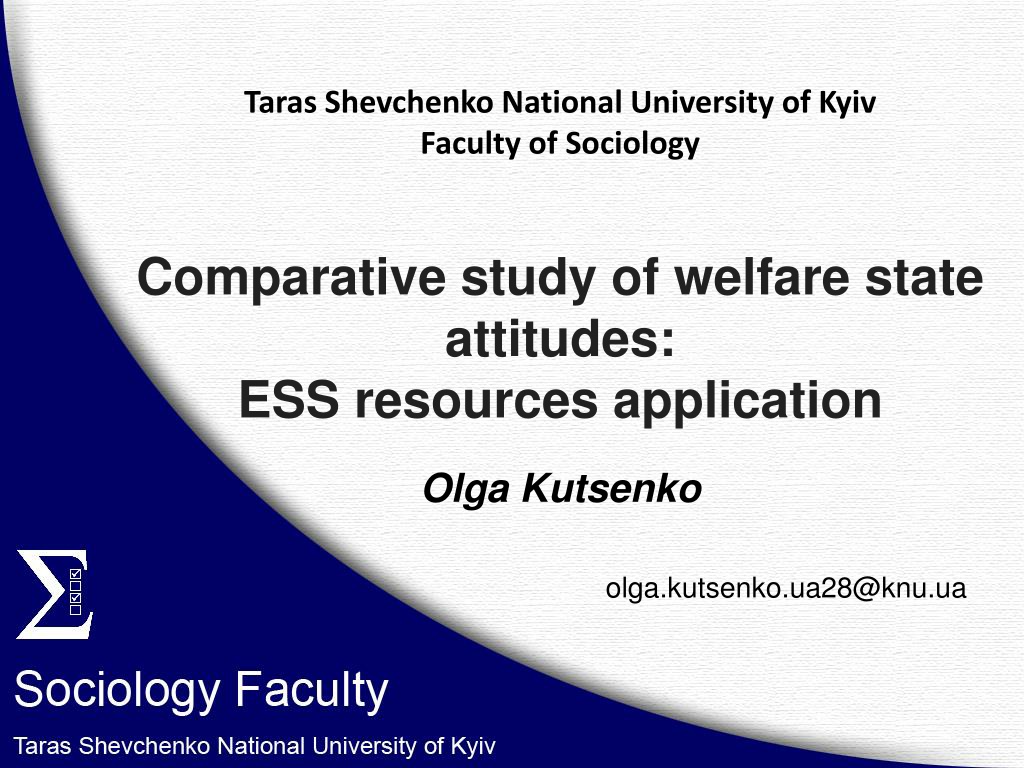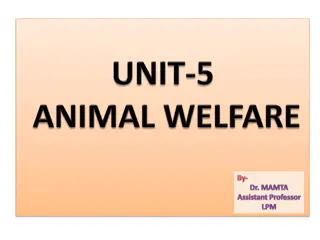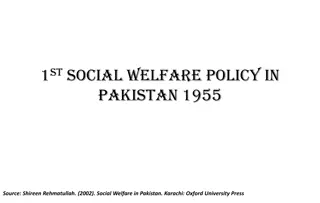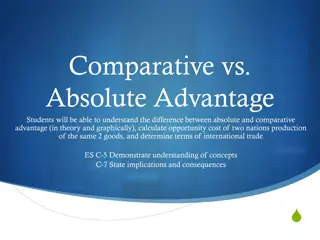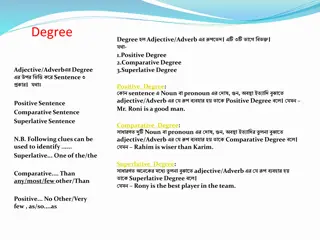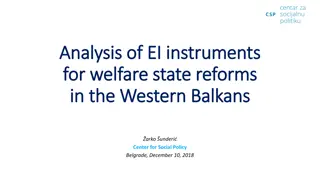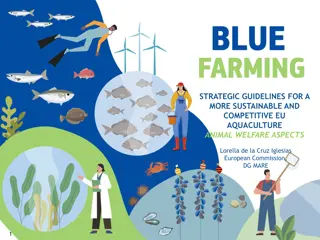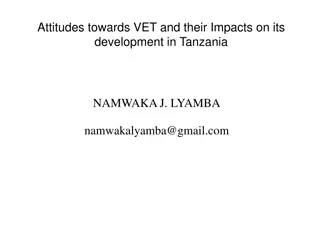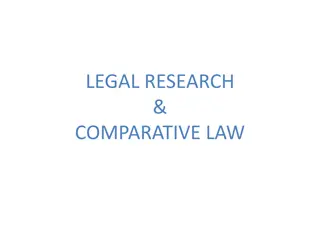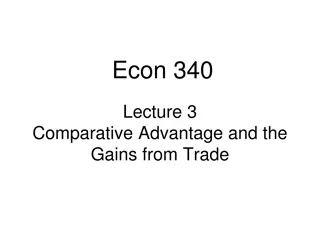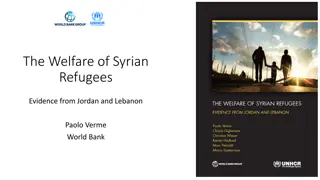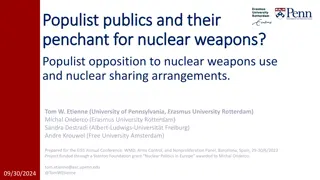Comparative Study of European Welfare Attitudes
Taras Shevchenko National University of Kyiv's Faculty of Sociology delves into the comparative study of welfare state attitudes in Europe. Analyzing data from 2006-2016, the research covers the evolving landscape of social protection, public expenditure, and challenges faced by welfare states. The study addresses issues such as population aging, non-standard employment forms, inadequate benefit levels, migration, inequality, and fiscal pressure. It also explores the shift in welfare state debates towards individual responsibility and private welfare arrangements. The study aims to understand citizens' attitudes towards welfare solidarity and their satisfaction levels with welfare state outcomes.
Download Presentation

Please find below an Image/Link to download the presentation.
The content on the website is provided AS IS for your information and personal use only. It may not be sold, licensed, or shared on other websites without obtaining consent from the author.If you encounter any issues during the download, it is possible that the publisher has removed the file from their server.
You are allowed to download the files provided on this website for personal or commercial use, subject to the condition that they are used lawfully. All files are the property of their respective owners.
The content on the website is provided AS IS for your information and personal use only. It may not be sold, licensed, or shared on other websites without obtaining consent from the author.
E N D
Presentation Transcript
Taras Shevchenko National University of Kyiv Faculty of Sociology Comparative study of welfare state attitudes: ESS resources application Olga Kutsenko olga.kutsenko.ua28@knu.ua
The Coverage of Social Protection in Total Population (global regions %, 2006-2016, The World Bank data)
Public social protection expenditure, excluding health, in Europe, 2013-2016 (percentage of GDP)* % % Norway, UK , Slovakia 14 Netherlands, Moldova 13 Estonia, Russian Fed. 11 Latvia, Lithuania, Romania 10 Albania, Georgia 9 France, Finland 23 Greece, Belgium 21 Ukraine 20,6 Denmark, Spain, Cyprus 20 Austria 19 Sweden, Hungary, Serbia, Slovenia 17 Germany 16 Poland, Croatia, Belarus 15 * The International Labor Organization data
Challenges to the Welfare States in Europe Disastrous effects of population aging, the growing number of pensioners. The changing world of work: the spread of non-standard and precarious forms of employment, temporary contracts, low pay, platform work The inadequate benefit levels in many countries which trap people in poverty, even those engaged in employment Effects of damaging traditional social ties and of weakening private forms of solidarity and self-help The growing migration, inequality A double bind of rising social benefit expenditures combined with declining government revenues and increased fiscal pressure Instability , environmental challenges The World Social Protection Report, 2017-2010, ILO https://www.ilo.org/wcmsp5/groups/public/---dgreports/---dcomm/--- publ/documents/publication/wcms_604882.pdf)l
The current emphasis in welfare state debates Shift from the solidaristic welfare state European style to the value of individual responsibility and, of private and informal welfare arrangements. (Taylor-Gooby, 2011). Again: Who should get what, and why + emphasis on the group membership dimension (who belongs to the imagined community of fellow citizens one feels responsible for).
What kind of state intervention into individual and social welfare do people in various European countries ask for? What attitudes do citizens in various European countries towards welfare solidarity? How satisfied are they with what the welfare state achieves?
European Social Survey 1. The ESS Round 4 module (fielded in 2008\-2009) Welfare Attitudes in a Changing Europe Principal applicant: Stefan Svallfors (Stockholm, Sweden) Data - 29 European countries including Ukraine www.europeansocialsurvey.org 2. The ESS Round 8 module (fielded in 2016/17) Welfare Attitudes in a Changing Europe: Solidarities under Pressure - provided a shift towards issues of the fairness, direction and degree of solidaristic redistributions and welfare reforms Principal applicant: Win van Oorschot (University of Leuven, Belgium) Data - 23 European countries without Ukraine https://www.europeansocialsurvey.org/docs/round8/questionnaire/ESS8_van_oorschot_prop osal.pdf
A conceptual framework for analyzing welfare state attitudes (Svallfors-2005, Oorschot -2012) Welfare state attitudes Welfare state scope and responsibilities Target groups / receivers Activation policies (R8) Welfare future preferences Predispositions Trust Personal experiences Risk perception Inequality beliefs Gender traditionalism Perceived social problems (R8) Evaluations Task performance (personal + general) Perceived consequences (economic, moral, social) Risks & resources: - Demographic factors Insecurity, precariousness, resources
Empirical research questions: What types of the welfare state attitudes do encompass European nations? Where is Ukraine located on the welfare attitudes typological map? Database: ESS-4 (2008\09)
Three empirical dimensions of the welfare attitudes (ESS-4, 2008\09) 1. Expectations of welfare state scope and responsibilities (StatResp) 2. Risk assessment of a welfare state (RiskSS) 3. Perceived consequences of a welfare state (BenfSS)
Risk assessment for the individual well- being in selected European countries ( no risks 0 < I < 3 very high risks ) Indicators: 1. Probability to loss of work 2. reducing of working hours and income 3. poverty 4. inaccessibility of medical care Self-estimation of individual risks UA RU 1.88 1.47 0.92 0.77 0.52 0.39 PL GB DE SE
Perceived consequences of a welfare state: two-factor solution for all countries (pooled data, principal component analysis, varimax rotation) Factors 1 0.849 To what extent do you agree or disagree that social benefits and services in your country 2 0.054 D29 make people less willing to look after themselves and their family? D27 make people lazy? 0.843 0.843 0.661 0.630 0.041 0.106 0.117 0.052 0.073 0.103 0.127 0.821 0.797 0.765 D28 make people less willing to care for one another? D21 place too great a strain on the economy? D25 cost businesses too much in taxes and charges? D23 lead to a more equal society? D22 prevent widespread poverty? D26 make it easier for people to combine work and family life? Percent of variance 38% 24%
Four empirical models of expectations and assessments towards the welfare state "Skepticism" - risk assessment of the welfare state and the accent on negative consequences for a society and the individuals. 1. 2. "Approval" positive assessment of the welfare state, and its social and individual consequences. 3. "Egalitarianism" the accent on social equity in wealth distribution in a society. 4. Etatism" significant assessment of a state itself and its role in the well-being protection in a society
Hierarchical clusterisation of 28 countries in 3-dimensional empirical space (Ward's method) 1 liberal (CZ, DE, GB) 1 2 continental (FR, BE, CH, NL) 6 4 3 soc.- democrat, Nordic (SE, NO, EE) 5 4 South Europe (ES, PT, TR, SL) 3 2 7 5 Greek- Cypriot (GR, CY) 6 post- Socialist, critical (PL, RO, HR) 1 1 2 7 post-Socialist (UA, RU, LV, BG)
Clusters of European countries in 3-dimensions concerning welfare state expectations and assessments, 7 national clusters Models of expectations and assessments of welfare regims 2 3 4 Nationally-based clusters of the welfare state attitudes 1 - Etatism Egalitaria- nism Skepticism Approval Mean 8,02 5,49 5,08 5,18 4 ES, PT, TR, SL Southern Europe (post- authoritarian, etatistic) higher Very high higher higher Mean 8,62 5,64 5,49 4,27 5 GR, CY Greek-Cypriot (etatistic egalitarian) Highest (max) Highest (max) Very high lower Mean 8,41 5,26 4,05 3,90 7 UA, RU, LV, BG post-Socialist (etatistic and egalitarian) Very high higher lower lower Mean 7,76 4,34 5,60 4,78 3 SE, NO, EE Social-democratic, Nordic (communitarian) 1 moderate lower Very high lower Mean 6,98 4,86 5,50 5,52 2 FR, BE, CH, NL Continental (solidaristic and critical)) Very low Lower Very high Very high Mean 7.22 4.36 5.08 5,49 1 CZ, DE, GB Liberal (critical) lower lower Higher Very high Mean 7,65 4,88 4,61 5,26 6 PL, RO, HR post-Socialist, critical but policy-oriented Lower lower lower Higher General Mean 7,77 4,98 4,87 4,97
The structural-based model of the welfare state attitudes, cases of 6 countries GB DE SE PL RU UA -0.108* -0.142* -0.103* -0.107* -0.167* -0.164* Skepticism Approval Etatism 0.079 0.052* 0.140* 0.099* 0.062* 0.000 -0.114* -0.094* -0.028 -0.172* -0.213* -0.197* 0.269* 0.271* 0.287* 0.274* 0.256* 0.140* Equality Trust Reciprocity Type of employment 0.056* 0.015 0.030 -0.037 0.111* -0.121* -0.059* -0.106* -0.037 0.000 0.006 0.034 0.060* 0.023 0.006 0.023 0.006 0.038 -0.018 -0.038 -0.108* -0.080* 0.039 -0.052 Gender Ag_25 and less Education 0.050* 0.000 -0.059* 0.112* -0.001 0.004 -0.078* -0.076* -0.035 -0.176* -0.067* 0.072 0.010 -0.018 -0.041 0.007 -0.095* -0.082* Urban Low income 0.041 0.035 -0.003 -0.065* 0.069* 0.108* R2 0.16 0.19 0.18 0.25 0.22 0.16
The main empirical findings (2008\09) 1. Two macro-clusters of the welfare state attitudes in Europe: I the continental and nordic ; II the southern and eastern; 2. Strong specificity of the post-Soviet welfare attitudes: the people are strongly in favor of welfare provision by the state, but they are disappointed about what their states actually deliver; 3. Skepticism is highly manifested in the welfare state attitudes in all European countries, besides the post-Socialist (especially post- Soviet) Europe. 4. The welfare state attitudes do not closely follow Esping-Andersen s three worlds of welfare capitalism. There are 7 different national clusters of the welfare state attitudes in Europe. 5. The values of equity and a state per se are the most predictors of the welfare state attitudes. There are sizeable differences in class effects on welfare attitudes between European countries, for which no successful explanations are found as yet.
Empirical indicators of three dimensions of mass expectations 1. Expectation of social responsibility of a state Additive index is calculated as the mean of variables D15-D20, highly correlates with the one-factor solution ( for every country). The one-factor solution explains from 47 % (for the Great Britain) to 57 %. The reliability coefficient Cronbach s , which characterizes the internal consistency of the additive index, is a rather high in each country and varies from 0.76 (for Great Britain) up to 0.84 (for Ukraine) The question and its alternatives: People have different views on what the responsibilities of governments should or should not be. How much responsibility governments should have to ? D15 - ensure a job for everyone who wants one? D16 - ensure adequate health care for the sick? D17 - ensure a reasonable standard of living for the old? D18 - ensure a reasonable standard of living for the unemployed? D19 - ensure sufficient child care services for working parents? D20 - provide paid leave from work for people who temporarily have to care for sick family members?
2. Assessment of social risks of a welfare state (RiskSS) The two-factor solutions (principal component analysis) for the data of each country have very similar structures and interpretations and explain quite similar amount of variance. For unification of the measurement s tool and for further cross-national comparison, the final factor analysis was done on pooled six countries data. Two-factor solution has the same clear interpretation and explains 62% of general variation. The estimated factors values were linearly transformed that allowed us to form next the index and index of estimation of social risks from a welfare state (RiskSS). The question and its alternatives: To what extent do you agree or disagree that social benefits and services in your country D29 make people less willing to look after themselves and their family? D28 make people less willing to care for one another? D27 make people lazy? D26 make it easier for people to combine work and family life? D25 cost businesses too much in taxes and charges? D23 lead to a more equal society? D22 prevent widespread poverty? D21 place too great a strain on the economy?
Percentage of unemployed persons in Europe receiving unemployment cash benefits, 2015 or latest available year, ILO data % % Germany, Austria, Finland 100 France Netherland Russian Fed 68 Denmark 67 Norway, Switzerl., UK 60-62 Spain, Belarus Portugal, Estonia Czech Rep 36 Latvia 33 Slovenia, Sweden Ukraine, Lithuania Greece, Croatia 20-21 Hungary, Poland Moldova 11 Azerbaijan, Kirgizstan < 2 Armenia 0 95 75 26 22 16-17 45 42 https://www.ilo.org/wcmsp5/groups/public/---dgreports/---dcomm/--- publ/documents/publication/wcms_604882.pdf
Public Spending on all Social Assistance Programs* in Post-Socialist Europe (% of GDP, 2013-2016, The WB data) Ukraine 4,4 2014 Russian F. 1,9 2015 Croatia 3,4 2014 Bulgaria 1,4 2014 Hungary 3,1 2013 Moldova 1,3 2016 Belarus 3,1 2015 Romania 1,1 2014 Slovak R. 2,4 2013 Latvia 0,8 2012 Poland 2,0 2013 Lithuania 0,5 2016 * cash transfers, in-kind, social pensions, school feeding, social works, fee waivers, other http://datatopics.worldbank.org/aspire/country/
In 2015 or latest available year (ILO data): Percentage of persons with severe disabilities in Europe receiving disability cash benefits, - 100%, except for: Austria, Israel, Portugal 90- 93% Spain 84 % Kirgizstan, Germany 76% Malta 60 % ; Cyprus 27% Percentage of population above statutory pensionable age in Europe receiving an old-age pension 100%, except for: Israel, Ireland 96-98 Tajikistan, Georgia, Ukraine 92-93 Russian Fed. 91 Greece, Albania 77 Moldova 75 ; Croatia 58 Serbia 46; Bosnia&Herz. 30
